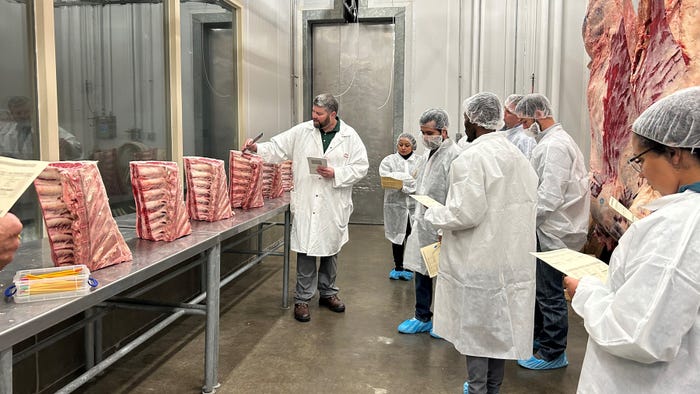
Prime. Choice. Select. Standard. Ask an average consumer at the grocery store, and chances are they will be able to tell you that those are the different beef grades. But what most consumers and maybe even some producers don’t know is how those grades get stamped on cattle.
At a recent USDA Cattle and Carcass Correlation Training Center event hosted at the University of Nebraska-Lincoln, stakeholders from production to processing to marketing gathered to deepen their understanding of USDA grading and the CME delivery system.
The purpose of grading cattle stems back to 1926 when cattle buyers wanted a standard for beef grading. Ultimately, this created a more consistent product across the market. When a consumer sees a Prime cut of steak, they have an idea of what flavor to expect.
In 2019, three training centers were established at West Texas A&M University, Colorado State University and UNL. The 2018 Farm Bill created these centers to provide a better understanding of the grading system and a networking opportunity for all facets of the beef industry.
Live cattle grading 101
Fat is everything when it comes to live evaluation of cattle. Understanding how and where cattle deposit fat is crucial to grading for both yield and quality.
Cattle will first deposit fat front to back, top to bottom. To see if cattle need more time on feed, the best indicators are assessing how full the brisket is.

GRADING TIME: USDA meat graders were able to teach the participants how to put a correct quality grade on six different beef ribs. It is important to take both maturity and marbling into consideration during evaluation.
The next step is to see how full the flank is back into the pones. When looking at the pones, if it looks like half of a softball on each side of the tail, that means that if genetics allow, this animal will quality-grade well.
But fat isn’t the only factor that evaluators take into consideration. Looking at true muscle definition and shape will help determine yield grades on the live side.
Carcass grading 101
Once those cattle are deemed deliverable, the next stop is the packing plant, where they will be given yield and quality grades based on the carcass.
The factors that are put into consideration for yield grades are fat thickness, rib-eye area, hot carcass weight, and kidney, pelvic and heart fat.
Quality grade is based on marbling and the age of the animal.
As for yield grading, this aids marketing when the beef is sold on the grid. This also gives a numerical measurement of the cattle for internal purposes. However, yield grading might be a dying art, as 66% to 68% of graded carcasses are done by a camera with new technology.
The future of grading is unknown. Something that might happen in the future is adding another level above Prime, like the Japanese markets, as cattle breeds such as Wagyu are throwing more marbling into the carcass. Nonetheless, grading is a crucial part of successfully marketing beef because it creates a common language for the cattle buyer, all the way to the consumer.
If you want to learn more about the USDA Cattle and Carcass Correlation trainings, click here.
5 things to know for cattle delivery
The Cattle and Carcass Correlation trainings drive home the importance of delivering a load of cattle that is CME-deliverable. Here are the top five things you need to know to deliver on your contract:
Have all your cattle at the stockyards at 9 a.m.
Don’t mix loads. Make sure your cattle are sorted into separate heifer and steer groups.
A load is about 28 head of steers or 31 head of heifers, depending on the size of animals. Total weight needs to equal 38,000 to 42,000 pounds.
There are about 3 to 5 head that are graded at a time. One load is graded per hour.
Bring extra cattle to make sure you can fulfill the contract. Different factors like dairy-influenced cattle, horned animals or animals that don’t make the correct weight can be deemed “undeliverable” by graders. Having a few extra head to make sure you can fulfill the contract is a recommended practice.
Read more about:
Beef QualityAbout the Author(s)
You May Also Like






